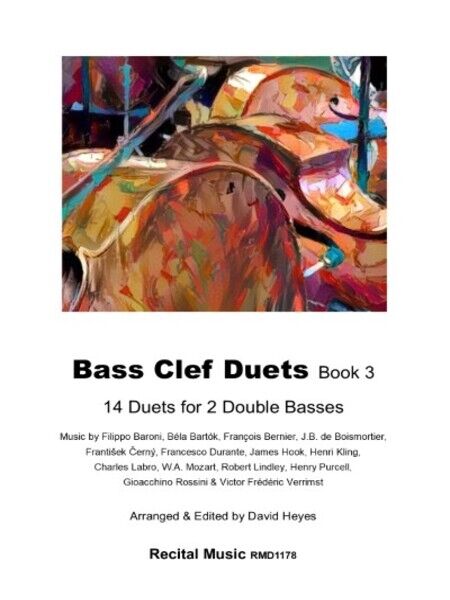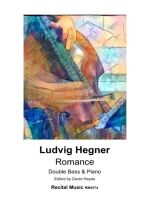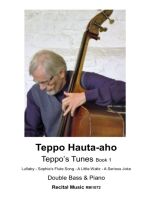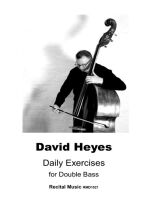Bass Clef Duets Book 3

Product code:
£12.50
Description
Bass Clef Duets Book 3 brings together 14 engaging and accessible double bass duets from the 16th to 20th-century. Edited and arranged by David Heyes, the duets are ideal as sight-reading music for the teacher and student, or as fun pieces to play with friends, and as accessible and inventive repertoire to play in recital and concerts, suitable for any audience or occasion.
Each piece has been carefully selected and edited, bringing together fourteen composers, featuring four original double bass duets and ten transcriptions.The edition includes a score and two solo parts for ease of performance.
- 1. W.A. Mozart (1756-1791) – Allegro
This short duet is the eighth of twelve duets (K.487), originally for 2 French Horns also arranged for basset horns and for many instrumental combinations. Composed in 1786, each duet is short and succinct, in a range of tempos and dance forms, and transcribe beautifully for double bass duet. - 2. František Černý (1861-1940) – Larghetto (Study No.123)
Transposed a fifth higher than the original, this duet was originally included in Černý’s Method for Double Bass (1906) and emphasises the lyrical and sonorous qualities of the double bass in the orchestral register of the instrument. - 3. J.B. de Bosimortier (1689-1755) – Légèrement (Sonata No.1)
Boismortier was a French baroque composer and this duet is originally for 2 bassoons and was composed in 1726. Sonata No.1 is in G major, transposed a fourth higher in this transcription, and Légèrement is the fourth and final movement. It includes canonic invention and contrapuntal writing for both basses, also playing in thirds. - 4. Victor Frédéric Verrimst (1825-1893) – Lesson No.1
Verrimst studied double bass at the Paris Conservatoire, where he also became Professor of Double Bass alongside his role as Solo Bassist at the Opéra de Paris. This duet, transposed a fifth higher than the original, was included in Solfège du Contre-Bassiste Op.129 and was composed in 1885. Bass1 was intended to be played by the student and bass 2 by the teacher. - 5. Filippo Baroni (1660-1716) – Primo Canone à 2. all’unisono
This vocal canon, taken from Canoni a due voci, is playable by any combination of bass clef instruments. Baroni’s book of vocal canons was published in Bologna in 1704 but very little is known about the composer. The canon is effective and ideal for study or concert use. - 6. Robert Lindley (1776-1855) – Rondo
Cellist and composer Robert Lindley was a great friend of Domenico Dragonetti (1763- 1846), and was described as “probably the greatest violoncellist of his time”. Rondo is originally for ‘cello and bass’, usually a solo cello accompanied by a 2nd cello, and is the second movement from Solo No.1. The piece is lively and entertaining, with something of interest for both bassists.
Description
Bass Clef Duets Book 3 brings together 14 engaging and accessible double bass duets from the 16th to 20th-century. Edited and arranged by David Heyes, the duets are ideal as sight-reading music for the teacher and student, or as fun pieces to play with friends, and as accessible and inventive repertoire to play in recital and concerts, suitable for any audience or occasion.
Each piece has been carefully selected and edited, bringing together fourteen composers, featuring four original double bass duets and ten transcriptions.The edition includes a score and two solo parts for ease of performance.
- 1. W.A. Mozart (1756-1791) – Allegro
This short duet is the eighth of twelve duets (K.487), originally for 2 French Horns also arranged for basset horns and for many instrumental combinations. Composed in 1786, each duet is short and succinct, in a range of tempos and dance forms, and transcribe beautifully for double bass duet. - 2. František Černý (1861-1940) – Larghetto (Study No.123)
Transposed a fifth higher than the original, this duet was originally included in Černý’s Method for Double Bass (1906) and emphasises the lyrical and sonorous qualities of the double bass in the orchestral register of the instrument. - 3. J.B. de Bosimortier (1689-1755) – Légèrement (Sonata No.1)
Boismortier was a French baroque composer and this duet is originally for 2 bassoons and was composed in 1726. Sonata No.1 is in G major, transposed a fourth higher in this transcription, and Légèrement is the fourth and final movement. It includes canonic invention and contrapuntal writing for both basses, also playing in thirds. - 4. Victor Frédéric Verrimst (1825-1893) – Lesson No.1
Verrimst studied double bass at the Paris Conservatoire, where he also became Professor of Double Bass alongside his role as Solo Bassist at the Opéra de Paris. This duet, transposed a fifth higher than the original, was included in Solfège du Contre-Bassiste Op.129 and was composed in 1885. Bass1 was intended to be played by the student and bass 2 by the teacher. - 5. Filippo Baroni (1660-1716) – Primo Canone à 2. all’unisono
This vocal canon, taken from Canoni a due voci, is playable by any combination of bass clef instruments. Baroni’s book of vocal canons was published in Bologna in 1704 but very little is known about the composer. The canon is effective and ideal for study or concert use. - 6. Robert Lindley (1776-1855) – Rondo
Cellist and composer Robert Lindley was a great friend of Domenico Dragonetti (1763- 1846), and was described as “probably the greatest violoncellist of his time”. Rondo is originally for ‘cello and bass’, usually a solo cello accompanied by a 2nd cello, and is the second movement from Solo No.1. The piece is lively and entertaining, with something of interest for both bassists.



